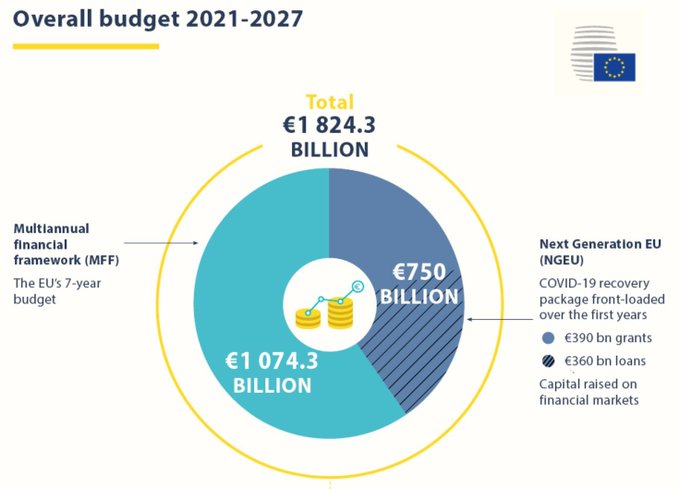On 21 July 2020, the European Council adopted conclusions on the recovery plan and multiannual financial framework for 2021-2027. EU leaders have agreed to a comprehensive package of €1 824.3 billion which combines the multiannual financial framework (MFF) and an extraordinary recovery effort under the Next Generation EU (NGEU) instrument. The MFF, reinforced by Next Generation EU, will also be the main instrument for implementing the recovery package to tackle the socio-economic consequences of the COVID-19 pandemic.
The size of the MFF - €1 074.3 billion - will allow the EU to fulfill its long-term objectives and preserve the full capacity of the recovery plan. New proposal brings some changes and cuts in the areas of health, migration, external action, InvestEU, HORIZON. The Just Transition Fund has been more than halved to €17.5bn - from the €40bn proposed in May by the EU Commission.
Next steps: European Parliament must give its consent to the next long-term EU budget.

Recovery fund
Next Generation EU will provide the Union with the necessary means to address the challenges posed by the COVID-19 pandemic. Under the agreement the Commission will be able to borrow up to € 750 billion on the markets. These funds may be used for back-to-back loans and for expenditure channelled through the MFF programmes. Capital raised on the financial markets will be repaid by 2058. €390 billion from the package will be distributed in the form of grants to member states and €360 billion in loans.
The amounts available under NGEU will be allocated to seven individual programmes:
- Recovery and Resilience Facility (RFF)
- ReactEU
- Horizon Europe
- InvestEU
- Rural Development
- Just Transition Fund and
- RescEU.
Allocation from the Recovery and Resilience Facility (RRF)
The plan ensures the money goes to the countries and sectors most affected by the crisis: 70% under the grants of the Recovery and Resilience Facility will be committed in 2021 and 2022 and 30% will be committed in 2023 .
Allocations from the RRF in 2021-2022 will be established according to the Commission’s allocation criteria taking into account member states’ respective living standards, size and unemployment levels.
For 2023 allocations, the unemployment criterion will be replaced by the drop in GDP in 2020 and 2021.
Governance and conditionality
In line with the principles of good governance, member states will prepare national recovery and resilience plans for 2021-2023 . These will need to be consistent with the country-specific recommendations and contribute to green and digital transitions. More specifically, the plans are required to boost growth and jobs and reinforce the “economic and social resilience” of EU countries. The plans will be reviewed in 2022. The assessment of these plans will be approved by the Council by a qualified majority vote on a proposal by the Commission. The disbursement of grants will take place only if the agreed milestones and targets set out in the recovery and resilience plans are fulfilled.
If, exceptionally, one or more member states consider that there are serious deviations from the satisfactory fulfillment of the relevant milestones and targets, they may request that the President of the European Council refer the matter to the next European Council.
Climate action
30% of the total expenditure from the MFF and Next Generation EU will target climate-related projects . Expenses under the MFF and Next Generation EU will comply with the EU’s objective of climate neutrality by 2050, the EU’s 2030 climate targets and the Paris Agreement.
Rule of law
The Union’s financial interests will be protected in accordance with the general principles embedded in the Union Treaties, in particular the values referred to in Article 2 TEU. The European Council also underlines the importance of the respect of the rule of law. Based on this background, a regime of conditionality to protect the budget and Next Generation EU will be introduced.
Rebates
Lump sum rebates on the annual gross national income-based contribution will be maintained for Denmark, Germany, the Netherlands, Austria and Sweden .
Own resources
EU leaders agreed to provide the EU with new resources to pay back funds raised under Next Generation EU. They agreed on a new plastic levy that will be introduced in 2021. In the same year the Commission is expected to put forward a proposal for a carbon adjustment measure and a digital levy, both of which would be introduced by the end of 2022.
The Commission would then come back with a revised proposal on the EU emissions trading scheme (ETS), possibly extending it to the aviation and maritime sectors. There may also be other new resources, such as a financial transaction tax. The proceeds of the new own resources introduced after 2021 will be used for early repayment of NGEU borrowing.
A €5 billion Brexit reserve will be established to support the member states and economic sectors hardest hit by Brexit.